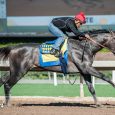 Albert Einstein is often credited with saying, “The definition of insanity is repeating the same behaviors and expecting a different outcome.”
Albert Einstein is often credited with saying, “The definition of insanity is repeating the same behaviors and expecting a different outcome.”
This begs the question: Are you repeating the same handicapping or betting behaviors and getting the same outcome that continues to leave you scratching your head about why you are not winning?
After getting serious about handicapping over 25 years ago, I was still wondering why I was losing money a few years later. After all, I had a solid foundation of knowledge and a great mentor, my Uncle Dutch, so why couldn’t I scratch out a profit?
I am the first to admit that I am a creature of habit and can be quite stubborn at times (just ask my patient and forgiving wife). Yet, a powerful lesson in my years as a line officer of a fire department taught me that sometimes you must reassess the situation to adapt your strategy, even if it means that you must deviate from your initial plan.
Is your handicapping the problem?
It turns out that my handicapping was fine. For years, I have tracked every race that I handicap based on breed, class, surface, and distance. I include the number of contenders I found in that race as well as my confidence level in my selections. The most amazing part of this tracking is finding out that I perform better in turf races I am confident about, as opposed to dirt races I am confident about.
I admit to having a natural aversion to turf races due to the often lengthy list of also-eligibles and questionable weather that often sees such races taken off the soggy green. These races often take extra time to figure or re-figure based on scratches and changes or inclement weather. Whereas I have always felt the most comfortable handicapping claiming races and passing on stakes races, my stakes race results are actually better.
If you find that you struggle in a specific type of race — turf sprints, stakes races, maiden 2-year-olds, etc., you need to rethink your approach to those races or pass over such races when you triage the race card.
Is your betting the problem?
 My betting was the problem. Not only did I track every race I handicapped, I also tracked every race that I bet on. I tracked my wager types by breed, class, surface, and distance. I found that my most profitable wagers were on the thoroughbreds, but did enjoy some success on the harness races. I found that win bets and multi-race wagers (the daily doubles, Pick 3, and Pick 4) were my strongest wager types. My wagering across classes, surfaces, and distances was consistent.
My betting was the problem. Not only did I track every race I handicapped, I also tracked every race that I bet on. I tracked my wager types by breed, class, surface, and distance. I found that my most profitable wagers were on the thoroughbreds, but did enjoy some success on the harness races. I found that win bets and multi-race wagers (the daily doubles, Pick 3, and Pick 4) were my strongest wager types. My wagering across classes, surfaces, and distances was consistent.
Since changing the wagers I focus on several years ago, I have seen my profits increase and have been able to apply more bankroll to where I know my strengths lie. I do still play some races and bets that are outside of my wheelhouse. I will shoot for a trifecta or superfecta if I am confident of how the pace will set up and I can eliminate a fair part of the field. Yet, I dedicate the majority or my bankroll to what works best.
Smart money management is also a key, but that is a big enough topic to warrant its own article in the future. However, before you can apply money management, you need to both have the right plays to bet and know what wagers work best for you.
Are both handicapping and betting the problem?
It is logical to say that if your handicapping is the problem, you will likely have a problem with your betting. If you can’t find any strengths from your current handicapping approach, it is time to stop the bleeding from your bankroll. It is time to reassess your approach either from reading a book or two for inspiration, finding some proven spot plays using beaten favorites, horses off of a layoff, second-time starters, horses coming back quickly, or following a profitable selection service or individual such as US Racing’s own Derek Simon.
There is no “one size fits all” approach to handicapping and betting, yet by knowing what races and wager types you are most competent in will keep growing your bankroll.




